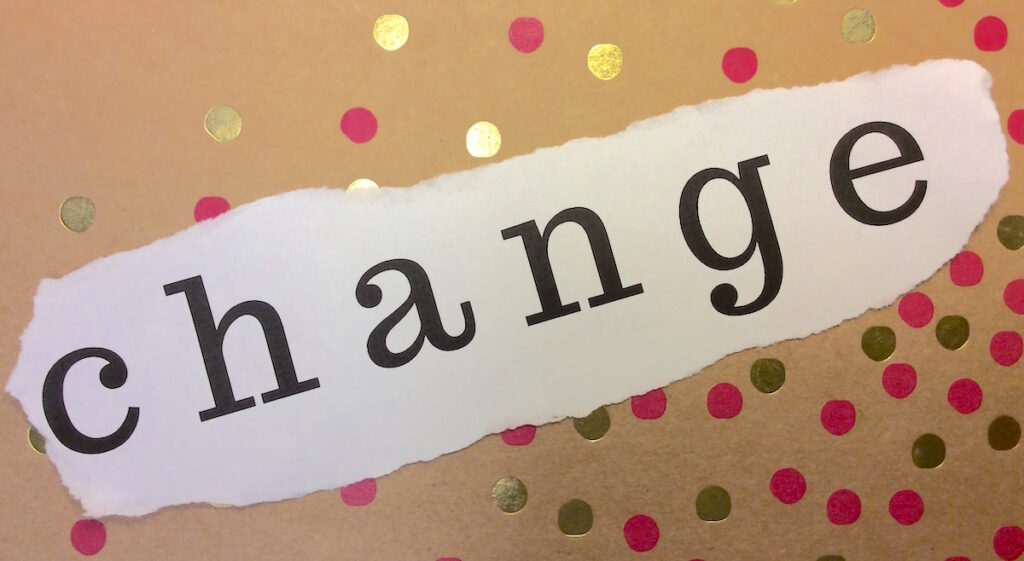Change. To become different. The thought can make your skin crawl. As teachers, we are asked to deal with change on a regular basis. Sometimes we are given changes that are great for our programs and leave us feeling excited and refreshed, such as a brand new classroom or an increased budget. Other times change can be difficult, especially when it is a decision that was made without our input. Things like budget cuts, technology issues, curriculum changes, and extra expectations.
Here are five ways to move forward and embrace change if you are stuck in a pity party for one.

1. Be Solution Oriented
Ask yourself a vital question that can help you to become solution oriented: How will this change drive my instruction forward? Every change (good and bad) presents us with the opportunity to move our instruction in a different direction. While it is easy to get caught up in how changes impact us, center yourself from the student perspective.
When you’re presented with a change, take time to write down the information and process later. Do not let your gut reaction become your standing ground. Use a list of pros and cons and be prepared to offer your feedback after the dust has settled. Always try to separate out your feelings and focus on factual information.
For example, let’s say you have been told your art room will be used as a science classroom the following year. After your first reaction passes, ask yourself what solutions are available to the roadblocks ahead. Go to your administrator with a list of ideas such as the need for storage space, several carts for different grade levels, and enough time to get between classes or switch materials.
2. Surround Yourself with Positive People
Find your sweet spot for support. Do not allow others’ negative views and feelings to bring you down. Trust yourself and your expertise to understand the change. Sometimes it is best to talk through the change with someone who is not in the middle of it. They will see things from an outside point of view and can help you to discuss the good and bad. Try not to spend your energy with others who are also upset about the change and look for the people in your life who will help you move to a positive place.

3. Have a Growth Mindset
Many schools are using Carol Dweck’s study on Growth Mindset to help students develop the “yet” attitude and move away from a fixed mindset. Students and teachers are encouraged to believe they can improve by embracing challenges, persisting through obstacles, and trying new things. On her website, Dweck argues those with a growth mindset are aware of positive and negative information but use it all for “learning and constructive action.” They ask themselves: What can I learn from this? How can I improve?
For example, maybe you have been told you have to take lunch duty every day. Instead of focusing on the negative, think about the opportunity you have to connect with students during one of their most social and vulnerable times of the day. You might see a change in art room behavior based on your connection with students during lunch. You can learn more about Dweck’s work by visiting the Mindset website or by reading her book Mindset: The New Psychology of Success.
4. Practice an Attitude of Gratitude
Take a moment to practice gratitude. Take time to reflect upon the things you are most thankful for in life. Acknowledge those things if you can. Write them down and focus your brain on the best things about your personal and professional life. If you have not seen Louie Schwartzberg’s video on gratitude and nature, it is a must see! His photography is paired with powerful words from David Steindl-Rast.
5. Be an Artist
Get lost in your artwork. Pick up a pen, pencil, paintbrush, camera or whatever tool you need to indulge in the creative process. On the most stressful days, I can hardly bring myself to take the time to make art but this is when my mind needs it the most. Step outside the house or into your studio and fully allow yourself to give in to the creative process. Your perspective may change after a little art therapy!
It is easier to develop a plan and practice it before you are thrown a curve ball. Think about how you can prepare for the next time change is on the horizon. Be ready to embrace the change with a handful of powerful strategies and don’t forget to focus on how lucky we are that we get to teach art!
If your district is requiring more of you and you’re feeling overwhelmed by the changes, be sure to check out AOE Courses. We have tons of resources and expert knowledge ready to help! You may especially be interested in Implementing the New Art Standards, Showing Student Growth in Art, and Reaching All Artists Through Differentiation.
How do you handle change at your school?
What lessons have you learned as you have endured or embraced change?
Magazine articles and podcasts are opinions of professional education contributors and do not necessarily represent the position of the Art of Education University (AOEU) or its academic offerings. Contributors use terms in the way they are most often talked about in the scope of their educational experiences.




